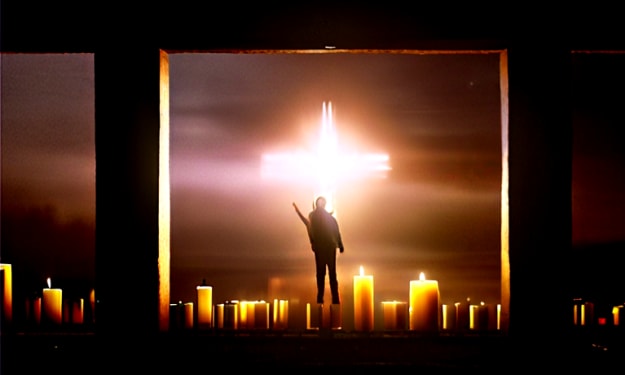
Sarah paddled her way through the Mississippi river. The river still ran border to border, and this was the fastest way she could make it to Minneapolis. “There used to be over a dozen Walmarts in that city,” Sarah reminded herself. She needed to reassure herself that she was doing the right thing, leaving Adam alone in Chicago for so many days. This will be the longest in 9 years that he would live alone. Sarah had never been away for more than a day before. She was never this desperate.
She could hear the last words Adam spoke before she left as if he was still right next to her.
“We are always together, right?”
“Always.”
Adam’s words echoing in her head was drowned out by the low hum of a Dronos dragonfly swarm. They were getting closer.
She clasped her locket as her jaw tightened. She knew as long as the locket was on her, she was safe from the dragonflies. But fear is hardly a rational emotion. Sarah could not see past the tall switchgrass along the banks of the river. But she could hear the hum getting louder. The swarm grew closer. Sarah paddled on without looking up. Her hand was steady, her breath intentional. Her heart beat raised.
The swarm passed and the hum disappeared. The rest of the journey would have to be on foot. She just needed two missing parts for the second necklace, Adam’s necklace. All she needed was a gyroscope and a radio frequency transmitter to complete the second one. The gyroscope generated power. As long as Sarah walked about 2 hours a day wearing it, it would have enough power to stay on. The transmitter is what hooks into the dragonflies local network and keeps them from detecting human life.
It was a wonder how some of Walmarts still stood. Sarah finally found the smartwatch with the macrogyroscope that she needed in the third Walmart she ransacked. Not as elegant as the one she designed back in the day at Caltech, but it’ll do. She fashioned the RF transmitter out of an old wireless keyboard. Once she had the parts, it was relatively easy for her to put it together. Sarah was, after all, the most famous bioengineer of her time. She and Adam would finally be able to leave the bunker together, she thought to herself.
Making her way back to Adam wasn’t particularly faster or slower. She still needed to paddle her way down the river from Minneapolis to Dubuque, and then trek for a week to get back to Chicago. The closer she got to Adam though, the faster she seemed to get there. She couldn’t wait to tell Adam that she found what she was looking for and that they would finally be able to step out together. She passed an old billboard near Freeport. “Starter homes under $5 million”, you could still read the faded out letters. How ridiculous dreams of houses and cars seemed now, living at the end of the world.
All the projections about the earth’s population maxing out at 9 billion by 2100 were wrong. They were simply projections of trends people already knew. People couldn’t have factored in how humanity would advance in the second half of the 21st century. The world couldn’t predict how advances in 3D-printed organs and automatic surgeries would change mortality. The turning point was in the year 2072, when the first heart transplant operation was performed in China not because there was anything wrong with the natural heart the person was born with, but because he simply wanted a better and more powerful heart. One which, like the engine of a connected car, could simply perform better with a software upgrade. For people who could afford enhanced organs, quality of life improved overnight. Over time, humanitarians made it their mission to make enhanced organ transplants and total cell replacement procedures accessible to everyone on the planet. The results were astounding. In less than 50 years, the human race entered an era of humanity where natural deaths became a thing of the past.
While the world celebrated the end of human suffering from disease, scientists from almost all other disciplines started sounding alarm bells. People simply didn’t die anymore other than from crime and natural tragedies. It wasn’t until almost a generation later though, when the population hit 19 billion. This was when the world’s leaders decided that the human race could simply not go on like this. There wasn’t a viable solution that could solve the problem. Sarah still remembers to this day the announcement of the population hitting its highest ever number. She was still in high school at the time.
The calling to save the world came to Sarah almost like a natural response to the world scratching its collective head looking for a solution. She wasn’t simply innovating, or inventing, she was saving the world. Fresh out of Caltech, brimming with ideas and ambition, Sarah had an answer to the world’s problem, one that would quickly make her both the most famous and the most controversial scientist of her time. She launched Dronos, her first baby, and served as both its Chief Executive Officer and Chief Scientist. She was the brains behind the dragonfly project. A painless, easy-to-implement answer for mankind’s biggest problem.
Sarah’s dragonflies were highly specialized drones, smaller and lighter than real dragonflies designed to use their sensors and recognition technology to track human beings. In seconds, they would inject a serum to make human beings sterile. Most people wouldn’t even feel a thing. Instead of thinking of the past and becoming kinder, the governments of the world took Sarah’s invention and led the future with ambition. As if ambition was going to get mankind out of the mess it had created.
World leaders called it the Case for Castration. There was a genuine population crisis, with an already oversubscribed planet being constantly pushed towards famine and greater environmental disasters. Too many people were still breeding, and virtually no one was dying. Cases of abandoned children rose at an alarming rate as parents realized they did not have the resources to take care of the children they brought into this world. With failed voluntary restraints, this huge welfare problem could only be addressed by forcibly reducing the number of fertile human beings alive on earth.
Dronos’s first dragonfly project was piloted in Bangladesh, one of the world’s most densely populated countries. The pilot was an exceptional success. The luddites who lived there fought back with everything they could think of - they used prehistoric camera drones to hunt the Dronos dragonflies, tried to hack them with close range cell towers and even tried to simply shoot them down. In the end, they simply couldn’t keep up with how fast the dragonflies could replicate using local resources. Sarah modeled her drones after dragonflies for a reason. Dragonflies are masters of flight and aerial attack. They can control their four wings to move in any direction they need to, and even hover in the air. They have a 95% success rate when they attack. Unlike people, they didn’t need to sleep. They could fly for a full day on a 30 minute suncharge. Their local hive mind, like a computer intranet, was self-learning. While they made decisions on an individual level, they were connected and shared information amongst their local networks using radio frequency. They were designed to be extremely energy efficient and completely self-propagating. In less than 2 years, at the turn of the 23rd century, The Dronos dragonflies had chemically castrated 99% of the global population. The population boom had been controlled.
Such draconian measures could never exist without resistance. People rose up across the world to fight the system. Black market operating rooms mushroomed into existence as people looked for any and every means to reverse their chemical castrations. With their primary purpose served, Dronos was soon authorized to retrofit the dragonflies for their second mission. A much darker mission. To hunt down the “reversed” and their illegal offspring. By making natural death obsolete, the human race now had to manufacture death. The retrofit was pushed out in the form of a systems upgrade: Software Patch 191B. The last patch Sarah had approved. Over the next few weeks, millions were dealt a hand of swift and painless death, many in their sleep.
Almost as soon as the dragonflies took to the skies again, people also started to get sick. They began to die. For a time, people blamed it all on the dragonflies. But Sarah knew the dragonflies would only poison the reversed - less than 20% of the population. Their venom could not explain why 90% of the human race died in months. A joke of cosmic proportions was being played out, and people were simply too slow to react and too heartbroken with grief to understand which disease had broken through the hundreds of years of human innovation. It was too late.
As the population dwindled, economic systems came to a grinding halt across the world. The resources and technology were still there, but there simply wasn’t anyone alive to move things to where they needed to go. Supply chains vanished. As the demands for power on electricity grids fell, it triggered automated nuclear power stations to cease operations, perpetuating a vicious cycle of global shutdown of systems. Fossil fuels sat unextracted and unrefined in their mines and reservoirs while gas stations ran dry. The only thing still fully functional were the swarms of self-sustaining and self-replicating dragonflies Sarah had created. And the only thing Sarah still wanted to do was to keep them as far away as she could from Adam.
Adam’s face lit up like a 200W flood light as he peered out of the bunker’s periscope and saw Sarah approach. He had been alone for over two weeks. He couldn’t care less about the rules of the bunker. He flung the bolt locks open and ran out towards Sarah.
“Adam!”
“Mom!”
Sarah gained as much speed as she could, her legs weary from the journey, and soon found Adam in her arms.
“I missed you so much baby. But you know you cannot run out like that. Not without your locket.”
“Sorry Mom.”
Adam wasn’t sorry.
“But, from now on, you don’t have to wait inside for me anymore. Look at what I got you!”
Adam hadn’t noticed till now that Sarah was wearing two lockets. Her original globe locket and a new heart-shaped one. His eyes widened in excitement.
“This one’s for me?”
“Yes Adam, this one's for you.”
“Does it have magic like your one does? Will it keep the dragonflies away?”
“I promise you. It will.”
It was a very happy day for Sarah and Adam. Phase one of her plan to leave the bunker was complete.
Sarah knew that she couldn’t spend the rest of her life in the bunker. Neither could Adam. What would be the point of being alive if he could never see this beautiful planet? If he could never meet other people? If he could never fall in love? What kind of life would he have after she was gone? What if there is a life out there for him, with other survivors? Are there other survivors? Someone to give him the chance of a life beyond fear?
Once Sarah was rested and the weather warmed up, they would start phase two. A half year long trek to Banff, home to some of the coldest mountain peaks in North America. Her theory was that the Dronos dragonflies could not operate beyond a certain altitude and could not fly at colder temperatures. Her second theory was that if anyone was still alive, that’s where they would be - up in those mountains.
As they left the protection of their bunker and started their journey, Sarah wondered if she was doing the right thing by exposing Adam to the dangers of the world. He was only 9. She was a weary 50 year old. Together, their chances of surviving such a long journey in the wild was low. The Dronos dragonflies were not the only risk. Wild packs of wolves and coyotes had quickly risen to the top of the food chain. Sarah knew she had to try, even if it ultimately costs her her life. She didn’t bring Adam into this world to grow old alone in a bunker.
Adam, on the other hand, was overjoyed. He wasn’t thinking of threats they could face along the 3,000 miles that separated them from the mountains they were headed for. This was the first time he would go beyond the safety markers that surrounded his bunker, the first time he would see the world and maybe even the first time he would meet other people. There was happiness in every step he took. He looked back at Sarah in sheer joy.
“Always stay close to me baby. Never walk too far ahead please.”
“Always together, right?”
“Always.”
About the Creator
Zee
A project manager by day and creative writer by night! New to the Vocal community and looking to discover new writers and stories!






Comments
There are no comments for this story
Be the first to respond and start the conversation.